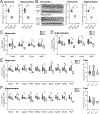Estrogen-related Receptor Alpha (ERRα) is Required for PGC-1α-dependent Gene Expression in the Mouse Brain
- PMID: 34648866
- PMCID: PMC9124582
- DOI: 10.1016/j.neuroscience.2021.10.007
Estrogen-related Receptor Alpha (ERRα) is Required for PGC-1α-dependent Gene Expression in the Mouse Brain
Erratum in
-
Corrigendum to "Estrogen-related Receptor Alpha (ERRα) is Required for PGC-1α-dependent Gene Expression in the Mouse Brain" [Neuroscience 479 (2021) 70-90].Neuroscience. 2022 Jun 15;493:119. doi: 10.1016/j.neuroscience.2022.05.011. Epub 2022 May 18. Neuroscience. 2022. PMID: 35594912 Free PMC article. No abstract available.
Abstract
Deficiency in peroxisome proliferator-activated receptor gamma coactivator 1-alpha. (PGC-1α) expression or function is implicated in numerous neurological and psychiatric disorders. PGC-1α is required for the expression of genes involved in synchronous neurotransmitter release, axonal integrity, and metabolism, especially in parvalbumin-positive interneurons. As a transcriptional coactivator, PGC-1α requires transcription factors to specify cell-type-specific gene programs; while much is known about these factors in peripheral tissues, it is unclear if PGC-1α utilizes these same factors in neurons. Here, we identified putative transcription factors controlling PGC-1α-dependent gene expression in the brain using bioinformatics and then validated the role of the top candidate in a knockout mouse model. We transcriptionally profiled cells overexpressing PGC-1α and searched for over-represented binding motifs in the promoters of upregulated genes. Binding sites of the estrogen-related receptor (ERR) family of transcription factors were enriched, and blockade of ERRα attenuated PGC-1α-mediated induction of mitochondrial and synaptic genes in cell culture. Localization in the mouse brain revealed enrichment of ERRα expression in parvalbumin-expressing neurons with tight correlation of expression with PGC-1α across brain regions. In ERRα null mice, PGC-1α-dependent genes were reduced in multiple regions, including neocortex, hippocampus, and cerebellum, though not to the extent observed in PGC-1α null mice. Behavioral assessment revealed ambulatory hyperactivity in response to amphetamine and impairments in sensorimotor gating without the overt motor impairment characteristic of PGC-1α null mice. These data suggest that ERRα is required for normal levels of expression of PGC-1α-dependent genes in neurons but that additional factors may be involved in their regulation.
Keywords: ERRα; PGC-1α; interneurons; parvalbumin; transcription.
Copyright © 2021 IBRO. Published by Elsevier Ltd. All rights reserved.
Conflict of interest statement
Conflicts of Interest: None
Figures






References
-
- Knutti D, Kralli A. PGC-1, a versatile coactivator. Trends Endocrinol Metab 2001. Oct;12(8):360–365. - PubMed
Publication types
MeSH terms
Substances
Grants and funding
LinkOut - more resources
Full Text Sources
Research Materials

